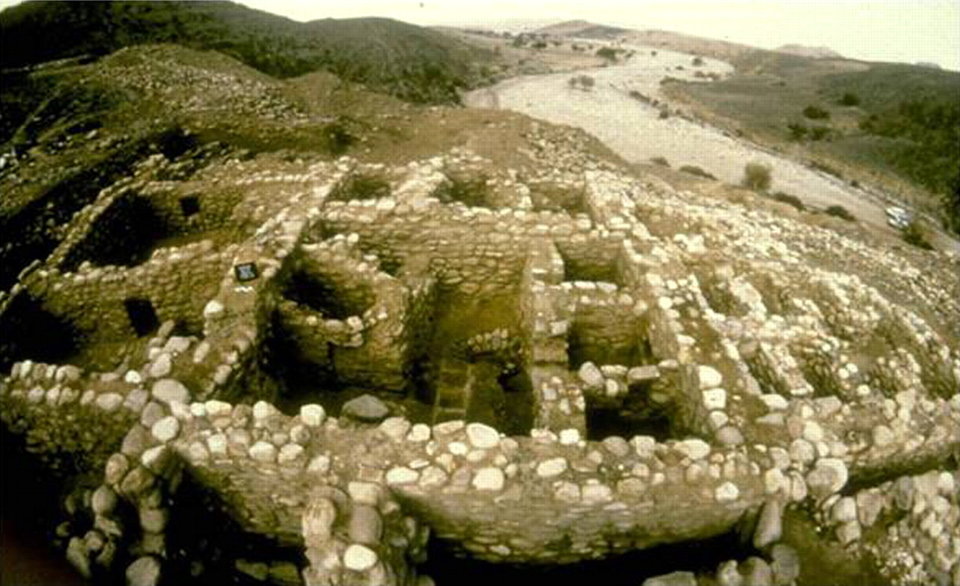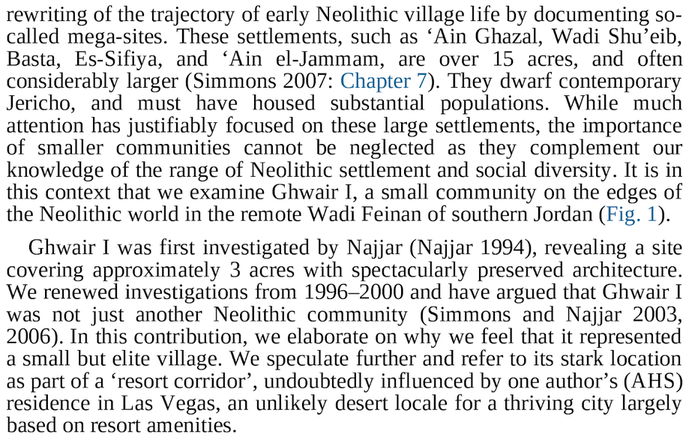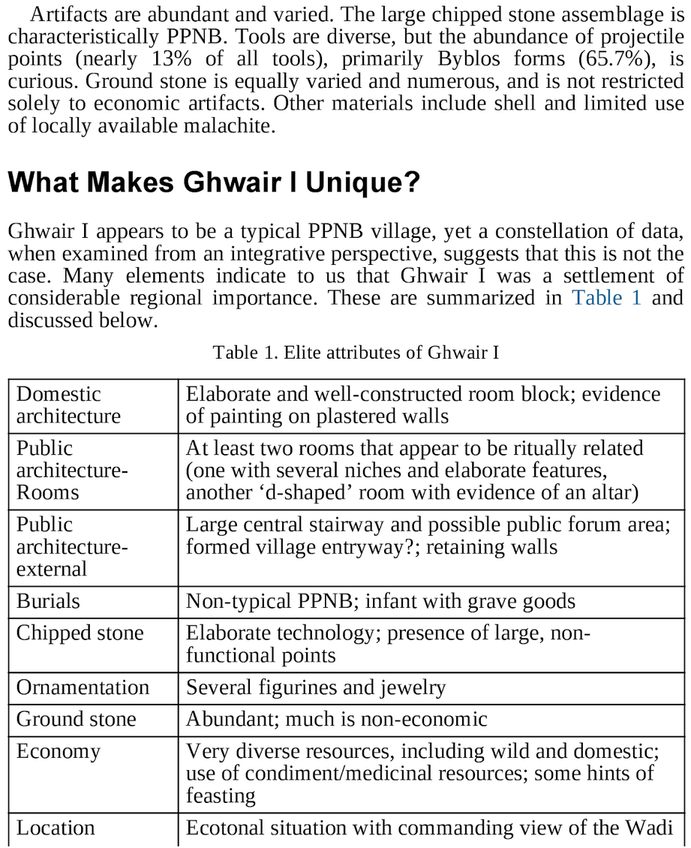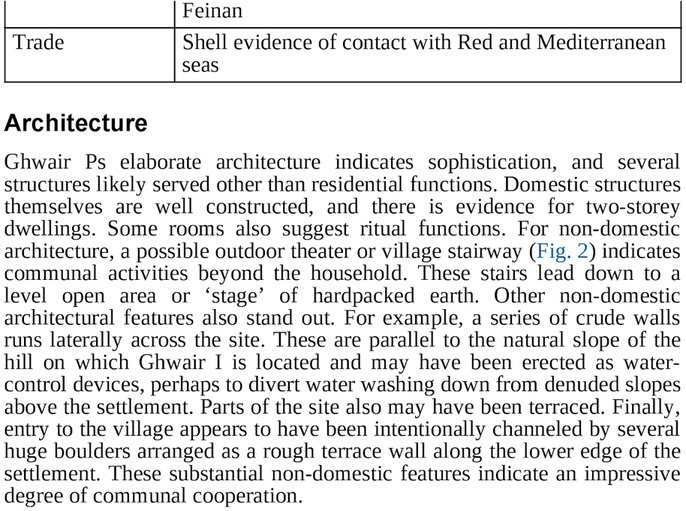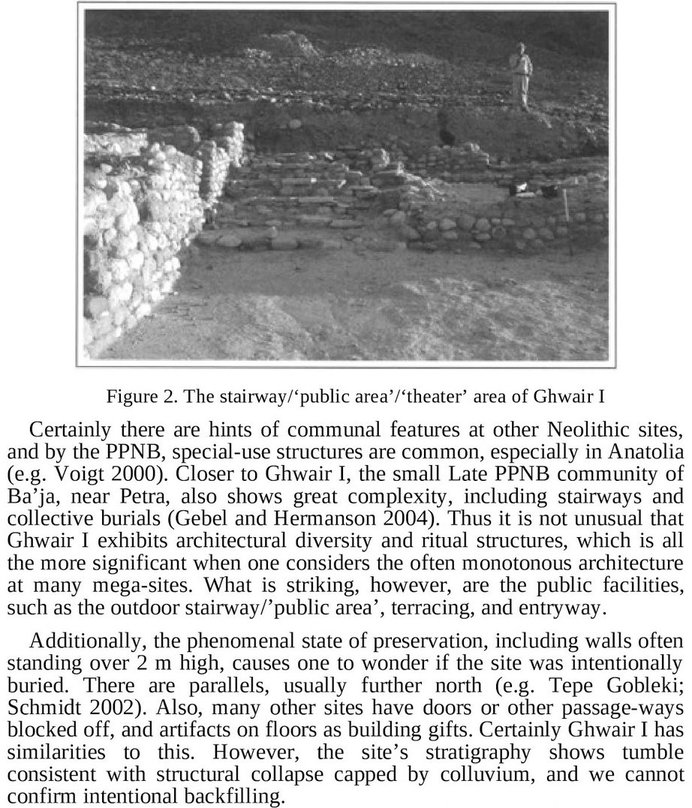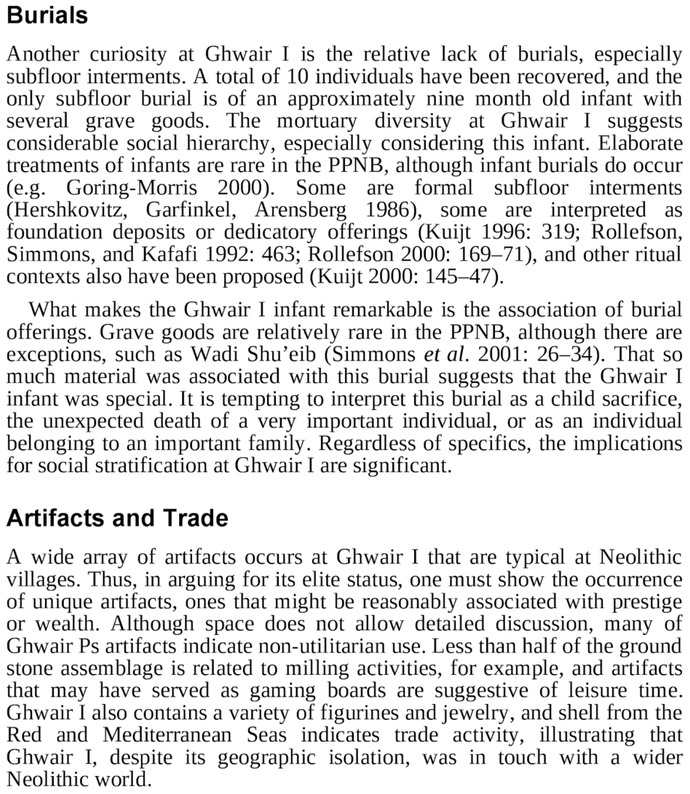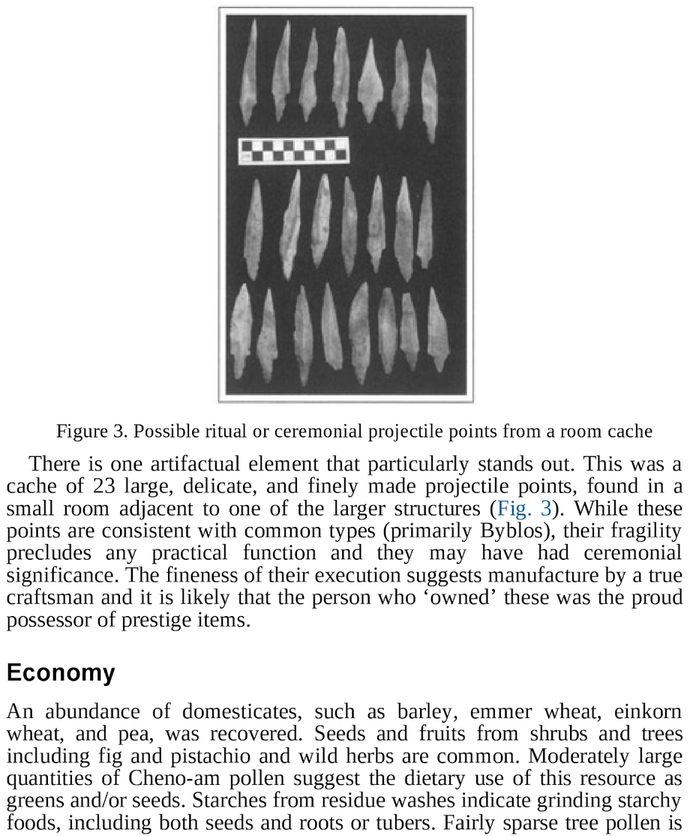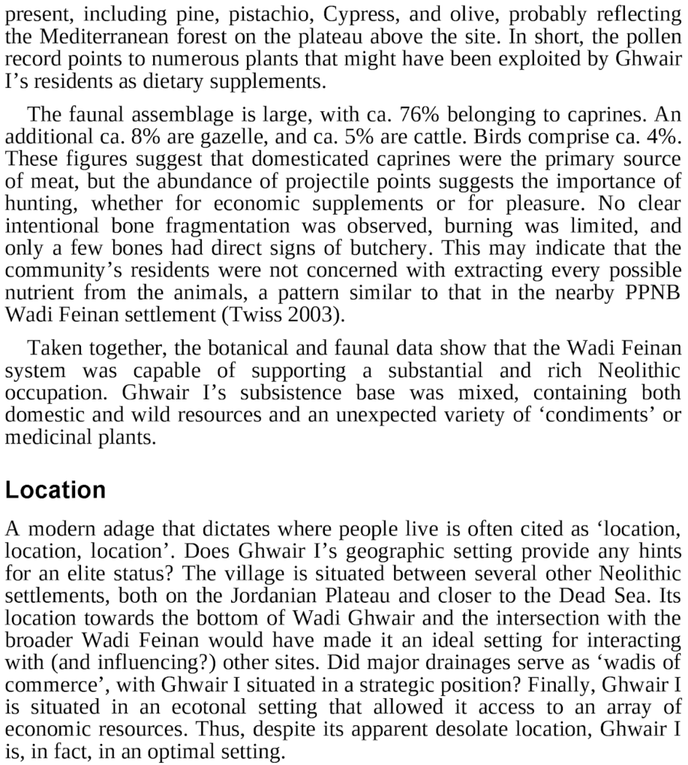|
Other Archaeological Sites / The Neolithic of the Levant (500 Page Book Online) Pre-Pottery Neolithic B (8880 to 8390 BP) Ghwair I Proofread and Updated April 29th 2019 Al-Ghuwayr I, a Pre-Pottery Neolithic Village in Wadi Faynan in Southern Jordan: A Preliminary Report on the 1996 and 1997/98 Seasons by Alan H. Simmons & Mohammad Najjar from the Annual of the Department of Antiquities of Jordan Pages 91-101 (1998) Ghuwayr I: a pre-pottery neolithic B settlement in Southern Jordan : report of the 1996-2000 campaigns by Alan H. Simmons & Mohammad Najjar from the Annual of the Department of Antiquities of Jordan Pages 407-430 (2003) JOINT CUSTODY: An Archaeological Park at Neolithic Ghwair I in Jordan by Alan H. Simmons and Mohammad Najjar in Near Eastern Archaeology Pages Pages 178-185 (2013) The Neolithic Revolution in the Near East: Transforming the Human Landscape by Alan H. Simmons Pages 169-174 (2011)
Ghwair I: A Small Complex Neolithic Community in Southern Jordan
Abstract
One of the primary research objectives was to examine if a “rural” and “urban” (or “core/periphery”) distinction could be made between Ghwair I and mega-sites. Our findings suggest that Ghwair I was not a peripheral village linked to larger sites. Rather it was an unexpectedly complex settlement that may have served as a local regional center ... Our results show that Ghwair I is firmly dated to the Middle PPNB; that artifactual diversity and variability is considerable, especially amongst chipped and ground stone; that the village became increasingly complex throughout its occupation; and that social organization was sophisticated as reflected by artifacts, burials and both residential and non-residential architectural features ... This paper concludes with a discussion of Ghwair I's place within the wider Neolithic world.
Environmental Adaptations at Neolithic Ghwair I as seen from a Zooarchaeological Perspective Abstract: Page iii: Understanding the Pre-Pottery Neolithic (PPN) environmental adaptations -- subsistence patterns and lifestyles in the southern Levant is pivotal in investigating the consequences of the human transformation from the exploitation of wild resources to the production of food through domestication or the "Neolithic Revolution". At the most fundamental level this investigation provides a comprehensive zooarchaeological study of the archaeological faunal assemblage from Ghwair I -- a Pre-Pottery Neolithic B (PPNB) community in southern Jordan -- in an effort to explore local exploitation patterns and refine our understanding of the community's social and economic systems. This type of investigation enhances our current understanding of the spatial organization -- village life and the eventual abandonment of villages at the end of the PPNB ... This investigation confirms that Ghwair I was a developed and socially complex community and provides researches with data to explore new ideas about human adaptations during the PPNB in the southern Levant. CHAPTER 1 --- INTRODUCTION AND RESEARCH OBJECTIVES Background: The Neolithic period of the Near East has long been the focus of studies on emerging social -- political -- ritual and economic complexities associated with increased sedentism and the consequences associated with transitioning from a foraging lifeway to one focused on agriculture. Tremendous change and profound shifts in social organization -- technology -- health -- diversity and economic innovations occurred as a consequence of the shift to a more sedentary lifeway focused on agriculture (Simmons 2007; Twiss 2007a, 2007b). Page 2: Previous attempts to understand the social and economic context of the transition to full blown village life, as well as further modeling of this transition, are constrained by several problems. First, until recently researchers have just begun to understand the spatial organization of human behavior within small to medium size villages, especially located in the peripheral zones of [the] southern Levant (Becker 1991; Banning and Byrd 1988; Byrd 1994; Bienert and Gebel 1998; Gebel et al 1988; Henry 2004; Mithen et al 2000; Simmons and Najjar 1996, 1998a, 1998b, 1999, 2000a, 2000b, 2001, 2003, 2006; Twiss 2003, 2007). Page 3: Research interest in the southern portion of the Levant for the past two decades has been driven by a renewed interest in the social -- ritual and economic variability of smaller communities in more marginal environments (Banning 1998; Finlayson and Mithen 2007; Mithen et al 2000; Simmons 2007; Twiss 2007). Research Questions and Objectives: Ghwair I, a PPNB community located in Wadi Feinan of southern Jordan firmly dated by a series of radiocarbon determinations to between 8880 to 8390 BP, provides an opportunity to improve our understanding of the social context of the food production and use during the PPNB and add to our current understanding of the spatial organization -- village life and the eventual abandonment of villages at the end of the PPNB. Page 4: Some researchers have hypothesized that desert-edge communities overexploited local resources and were forced into major economic re-adaptation in these so-called “peripheral” regions (Bar-Yosef and Belfer Cohen 1989a; Renfrew 1986; Gebel 2002). Changing climatic patterns starting with the Younger Dryas have been hypothesized as a factor impacting people during the early stages of developing agricultural subsistence economies on through the PPNB (Bar-Yosef and Meadow 1995:44). Increasingly arid landscapes would have forced desert-edged communities to change their cultivation technologies -- herding strategies -- resource exploitations and water management. Ultimately the research adds to our understanding of whether the occupants of Ghwair I and other sites in the Wadi Faynan contributed to environmental degradation and abandonment of the area. CHAPTER 2 --- CULTURAL AND ENVIRONMENTAL CONTEXT OF THE SOUTHERN LEVANT Page 11: The earliest expression of the Neolithic in the Levant is referred to as the Pre-Pottery Neolithic (PPN) or Aceramic Neolithic. The PPN emerges from the Natufian cultural complex (circa 12,800-10,200 BP) around 10,500 BP and is marked by increased settlement size and economically characterized by the shift from an essentially hunter-gatherer strategy to one of food production through domestication of plants and animals (Simmons 2007). Pages 12-13: The present study focuses on the archaeological site of Ghwair I, a small and richly preserved PPNB community that is located in the remote Wadi Feinan region of Jordan in the southern Levant. Geographically Ghwair I is located approximately 200 kilometers southwest of Amman Jordan and 120 kilometers north of [the gulf of] Aqaba in the Wadi Feinan region, a transitional zone between the Dead Sea Valley and the Jordanian Plateau. The settlement is situated on a hillside at an elevation of 290-320 metres above sea level with a spectacular view of Wadi Feinan; the site covers approximately 1-1.2 hectares. The area is a degraded step desert with unstable soils and Saharo-Arabian vegetation or open xeromorphic scrub, sparsely dispersed across the landscape with some salt-tolerant flora flourishing where the groundwater is saline (Colledge 1994; Horowitz 1979). Paleoenvironmental Conditions: Pages 15-16: The emergence of the Holocene brought about a warmer interglacial period. Early Holocene environmental conditions appear to have been mostly dry with some moist periods during the Neolithic (9000-8500 B.P.) The gradual processes of desertification within the southern Levant resulted in a gradual expansion of the steppe zone (Henry 1989). This process stabilized by 8,000 B.P. with the rainfall patterns predominant during the Neolithic only slightly higher then those of today. Within this environmental context mobile hunters and gatherers had made the transition to a sedentary lifestyle during which settled village life and plant cultivation became commonplace by the end of the PPNA (Simmons 2007). Initially there was a diverse subsistence strategy in which both wild and domesticated plant and animal species were exploited. During the PPNB increased sedentism -- increased population size -- domestication of plants and animals and the proliferation of expanding villages were ushered in (Bar-Yosef 1981). The associated economic -- technological -- social and symbolic transformations occurring during this period heavily influenced how humans interacted with their environment and each other (Simmons 2007). These transformations and interactions were manifested in material culture, primarily in the public architecture -- lithic materials -- burial practices-- ceremonial objects and the domestication of both plants and animals in the region. Page 45: The excavation at Ghwair I throughout the years has demonstrated that this relatively medium size village (3 acres) was occupied in the early stages of the PPNB between circa 8880 ~ 8390 BP (Simmons 2007). Although only five areas have been excavated substantial artifact -- fauna and plant assemblages have been acquired due to the outstanding preservation (Powell et al 2003). Page 49: Both chipped and ground stone are abundant at Ghwair I. The chipped stone artifacts of Ghwair I reflected a typical PPNB blade-dominated assemblage. More than 60,000 artifacts have been recovered with tools representing approximately 5.4% of all chipped stone (Powell and Gervasoni 2000). Projectile points dominate chipped stone tools. Sickles and other implements also are common and bladelets are plentiful.
Chapter 27 --- Life in the Resort Corridor --- Ghwair I, a Small but Elaborate Neoithic Community in Southern Jordan by Alan Simmons and Mohammad Najjar
See: Jericho --- Dame Kathleen Kenyon: Digging Up the Holy Land
See: Neolithic 'Ain Ghazal in Jordan --- The Wadi Feinan (Faynan) District in Jordan
See: Neolthic Levant
Dead Sea --- Pre-Pottery Neolithic B --- Neolithic 3 Byblos Lithics
See: Anatolia --- Göbekli Tepe
|
